Public Toilets Case Studies with Pratt Institute: Amsterdam, Netherlands
Research with MFA student Keliang Li
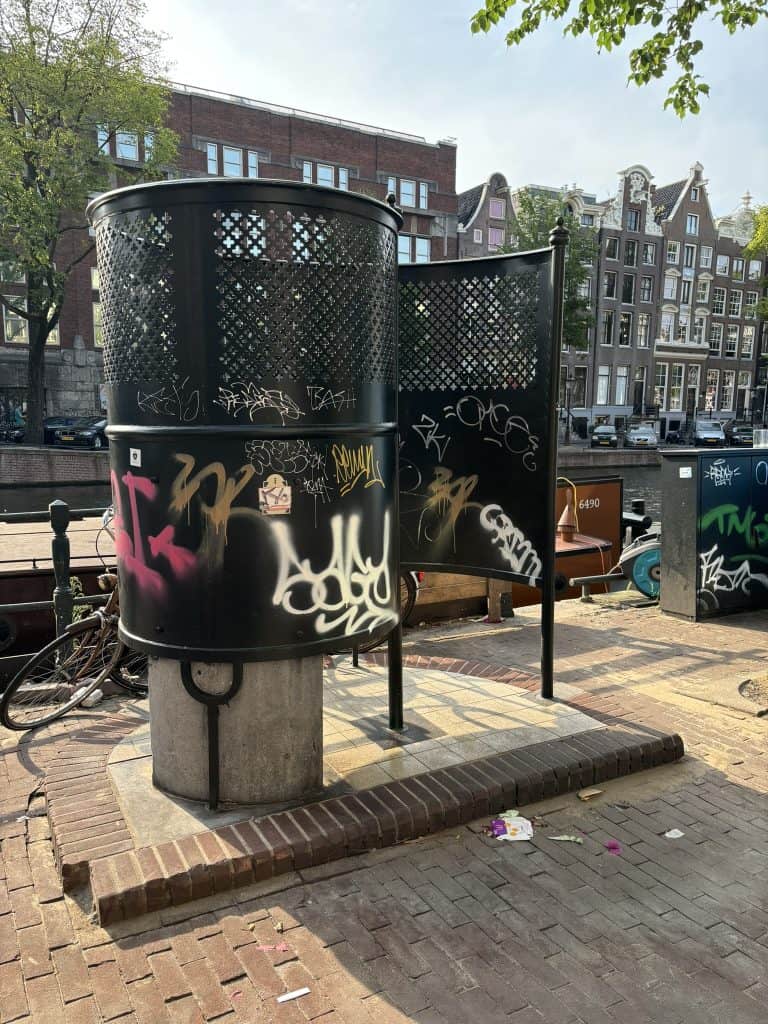
Pee Curl, or public urinal for men, in Amsterdam
On a recent trip to Amsterdam, when I asked a local shop owner where I could use the restroom, she told me there were plenty of places for men but it was not so easy for women. She pointed me in the direction of a local bar down the road that generally let people use the restroom for free. Luckily, the restaurant was open and allowed me to use the restroom without a purchase.
As of 2020, Amsterdam had 112 public toilets, less than half of which may be easily used by women or people with an ambulatory disability. There are 56 for men and women, 50 for wheelchair users, and 34 that are free. However, some say that the city still lacks public toilets, especially for women and people with disabilities.
City spokesperson Robbin van Pelt says Amsterdam has been working to expand public toilet access over the last five years by conducting research, installing mobile toilets and asking local organizations to make their bathrooms open to the general public. They did not say how many new toilets will be installed, but that they will be spread out across seven city parks.
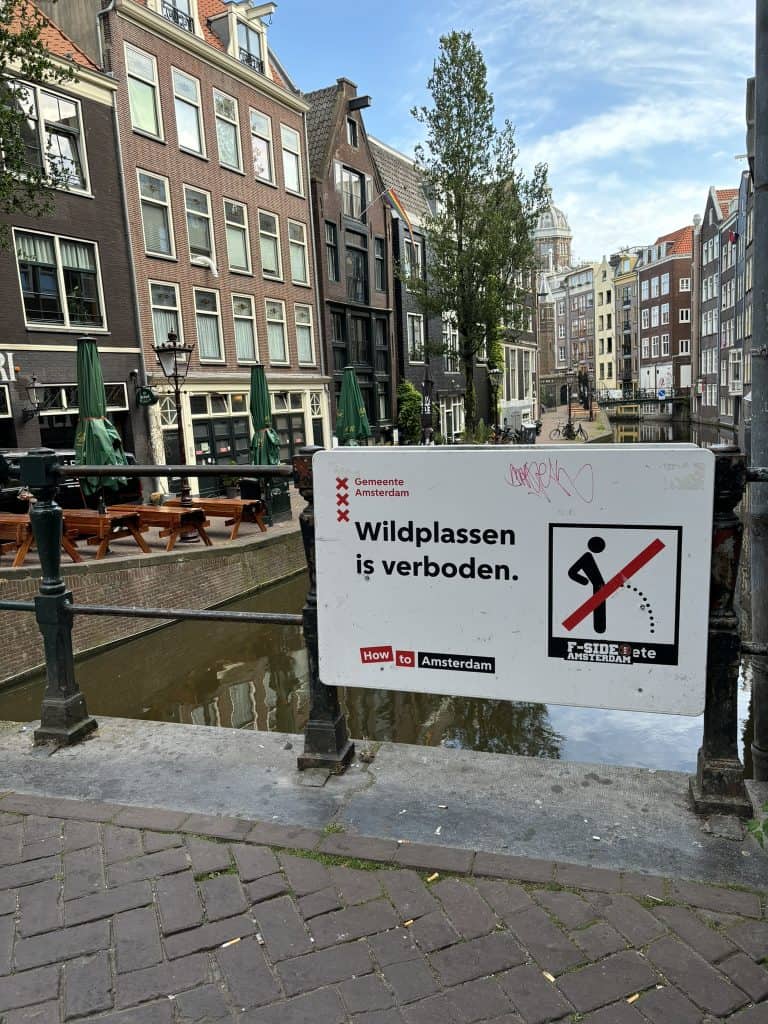
Sign in Amsterdam, translated in English to read, “No public peeing. It’s illegal.”
“It would not be pleasant but it can be done”
In 2015, Amsterdam had 35 public urinals for men and only three public toilets for women. It was past the closing time of local bars, and Geerte Piening, 23, was a couple of kilometers from the nearest women’s toilet facility. She asked her friends to cover for her as she urinated on the street in Amsterdam’s Leidseplein district, and was fined as a result of doing so. Piening decided to fight the charges in court, only to be criticized by the judge who said that despite the lack of toilets available for women, she should have made use of the facilities made available to men.
“It would not be pleasant but it can be done,” the judge told her.
As a result, a series of protests were held and the movement towards women’s access to public toilets increased. The incident highlighted how the design of cities often reflects a tradition of women staying in the home, and can actively exclude segments of the population if left unchallenged. “I think the city is mostly built by and for men,” Piening said. “So if I look at it from that angle, it isn’t surprising that there are only urinals for men.”
Wayfinding in Amsterdam
“You have to know where they are to use them, or otherwise use an app.“
While in Amsterdam, I used the Amsterdam map, shown above to locate restrooms. As you can see, the most frequent icon is the circle, representing the urinal. While the map did help me find restrooms and locate urinals, I often arrived to find the restrooms closed, underground, or out of service. Throughout the day and night, the only reliable, open place to go were the urinals.
Although Amsterdam has a standard for a public toilet to be located within every 500 meters, there are many areas in Amsterdam Centrum where this distribution is not met. According to the Court of Audit, the main cause behind the lack of public toilets is their cost. Amsterdam will need to build 25 to 30 additional public toilets in order to meet the city council’s standard, at an estimated cost of approximately 4 million euros, and another 300 thousand euros per year for management costs.
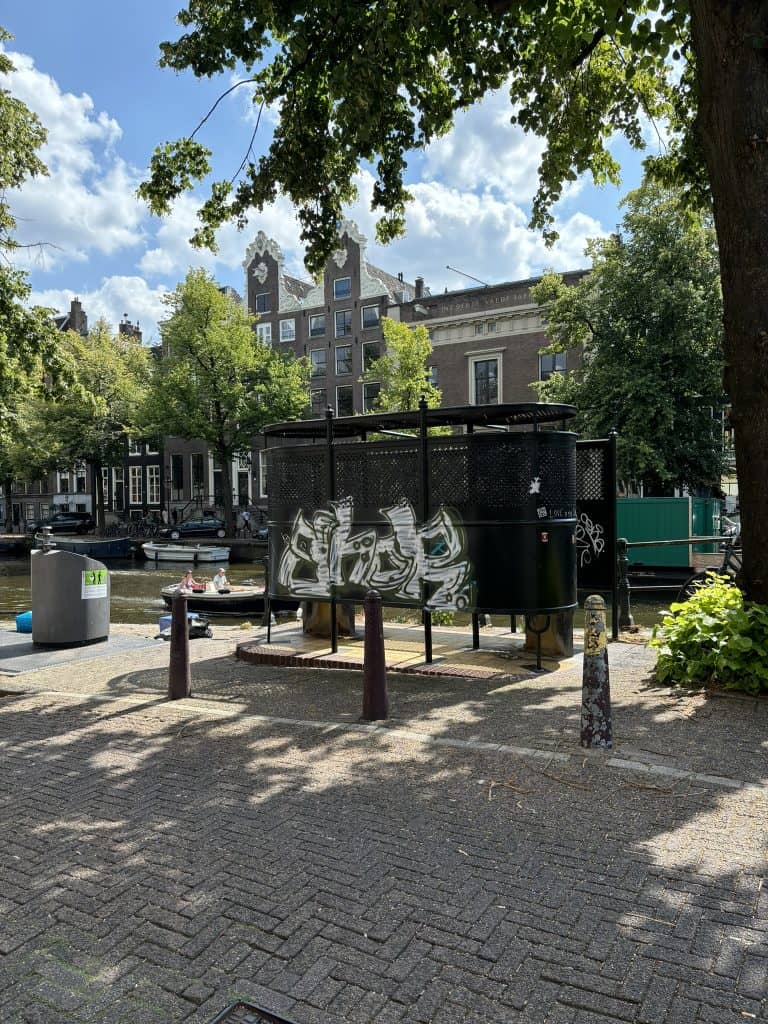
The Pee Curl’s are often located along canals. This image is of a multiple user pee curl.
The Pee Curl
With all the different public toilet options in Amsterdam, including public toilets, seasonal toilets, pop-up toilets, and urinals, the most commonly found are the urinals. In Amsterdam, “pee curl” are unique cast-iron urinals named for their shape. The top half of the plate is perforated so that any passers-by can determine at eye-level whether it is vacant or in use, and the solid portion is at about knee height, to easily see how many people are within the urinal. The model also comes in a single user size and larger scale for multiple users.
The first curls were placed around the city in 1870. They are connected to the sewer and are cleaned by the local municipality with water from the canal. The outlook of curls is simple, functional and in two variants; single or double curl. The design and location of the urinal allows officers on duty to see at a glance how many people are in the urinal. They were originally designed and implemented to discourage people from urinating in public, for reasons including odor nuisance, outbreak of diseases, damages to buildings and urinating into the canal – with the possibility of falling in as a result.
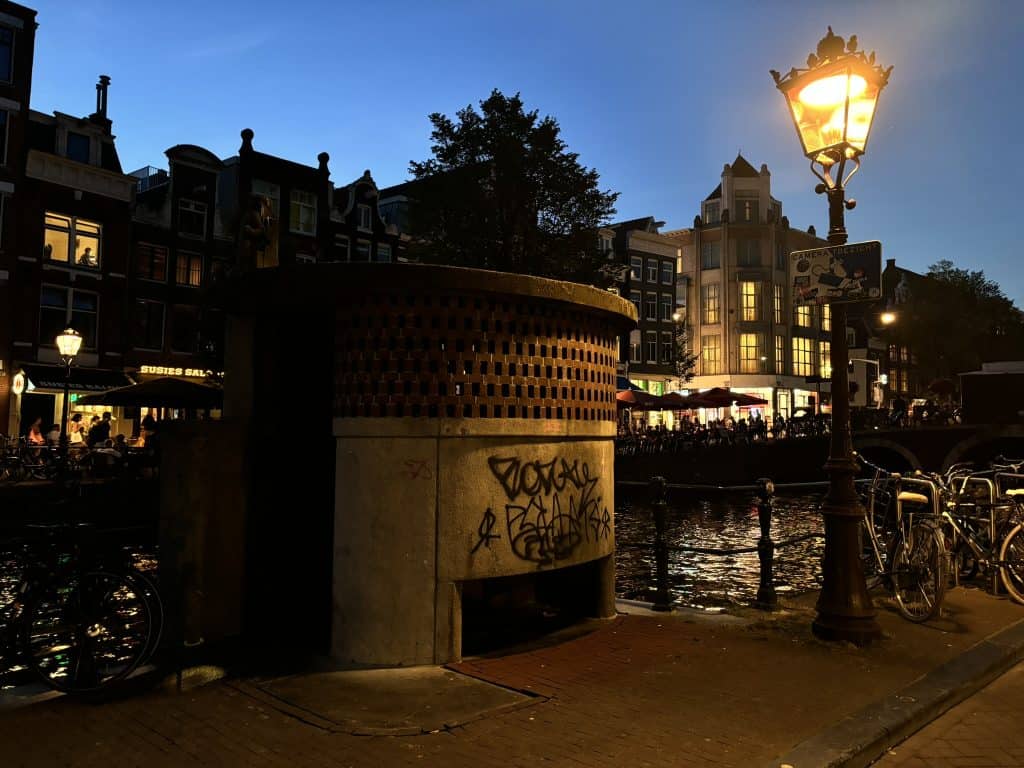
Public Urinal in Amsterdam along the canal, designed for men only
Amsterdam’s Public Urinals
A different model of the urinal was designed to blend in with the architecture of the city. Consistent with the pee curl, it is open air and perforated to see how many people are inside, yet much more enclosed than the cast iron model. An issue commonly raised with the urinals is that the smell around them is quite strong and they do not seem to be washed very often. Still, they are successful in centralizing where men are relieving themselves. Historically this has been an issue, causing problems including damaged property and spreading of disease.
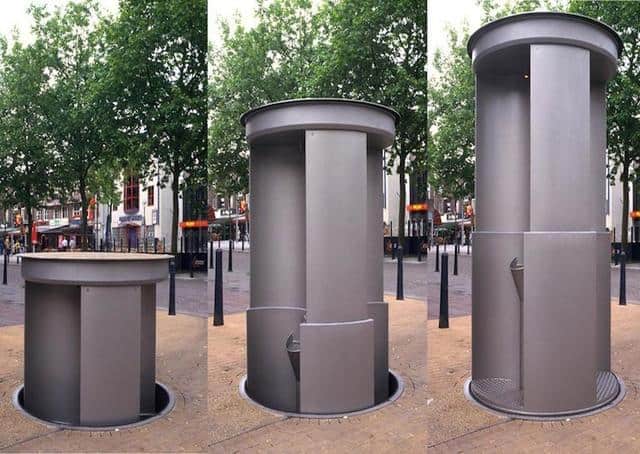
Pop-Up Urinal by Urilift, rising from underground to street level.
Pop-up Toilets
The Dutch invented Urilift is an innovative and insightful solution to this very visible (and smellable) issue. Placed where it is needed most, the Urilift is only above ground when needed. For the rest of the time, it is completely hidden under ground. The idea is to keep the “eyesore” of a restroom out of the way and give more open space to pedestrians during the day, when shops and restaurant restrooms are available, and to be lifted and available at night when those establishments are closed and nightlife is thriving. The contraption appears from the ground by pressing a small remote control – a prerogative which in Amsterdam is reserved for municipal authorities, policemen and a few, select bar owners.
Urilift pop-up toilets are designed with multiple variations. Urilady is a single cabin for the ladies, Urilift has three urinals around a central piece, and Urilift Combi is a combination of both. With the design of the pop-ups facilties that include enclosed toilets, the inequitable access to genders begins to be addressed. Despite limited tangible changes at this point, there has been significant momentum since 2015 to fight this potty parity.
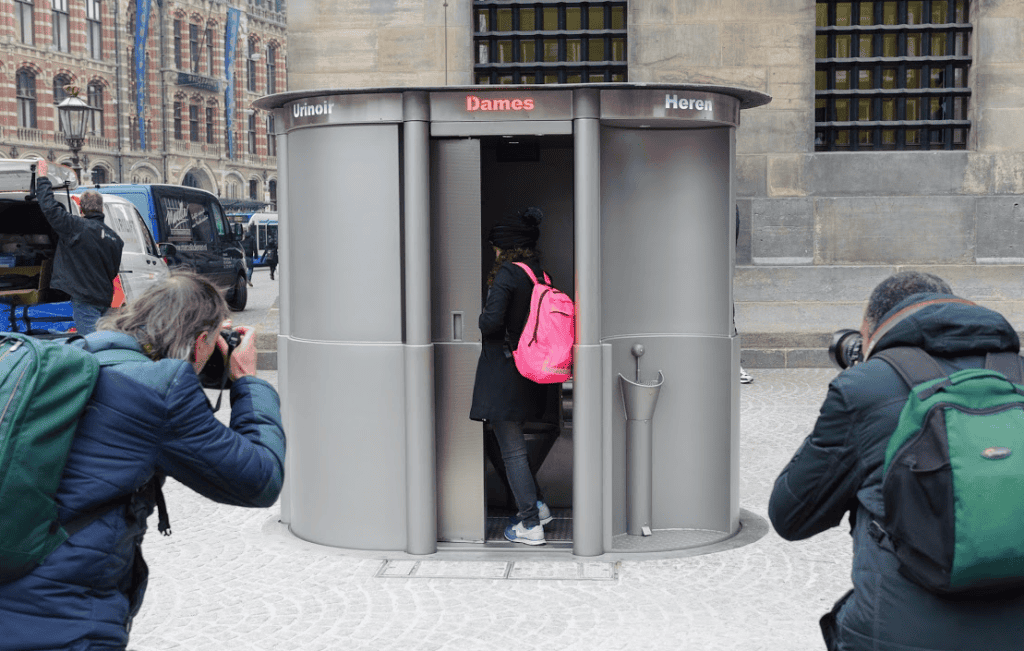
The first retractable women’s toilet was installed in Amsterdam, by Urilift.
The city’s Dam square has become the world’s first public space to be equipped with a retractable women’s toilet. The enclosed toilet, made of vandal-resistant stainless steel, sits underground during the day. At night the cabin, also equipped with two urinals for men, rises above the ground and ready for use. While under ground, the cylinder is cleaned, making the urinal come up fresh and clean each time it is summoned by the remote. The ladies urinal is flushed after each user and the male urinals are automatically flushed 6 times per hour.
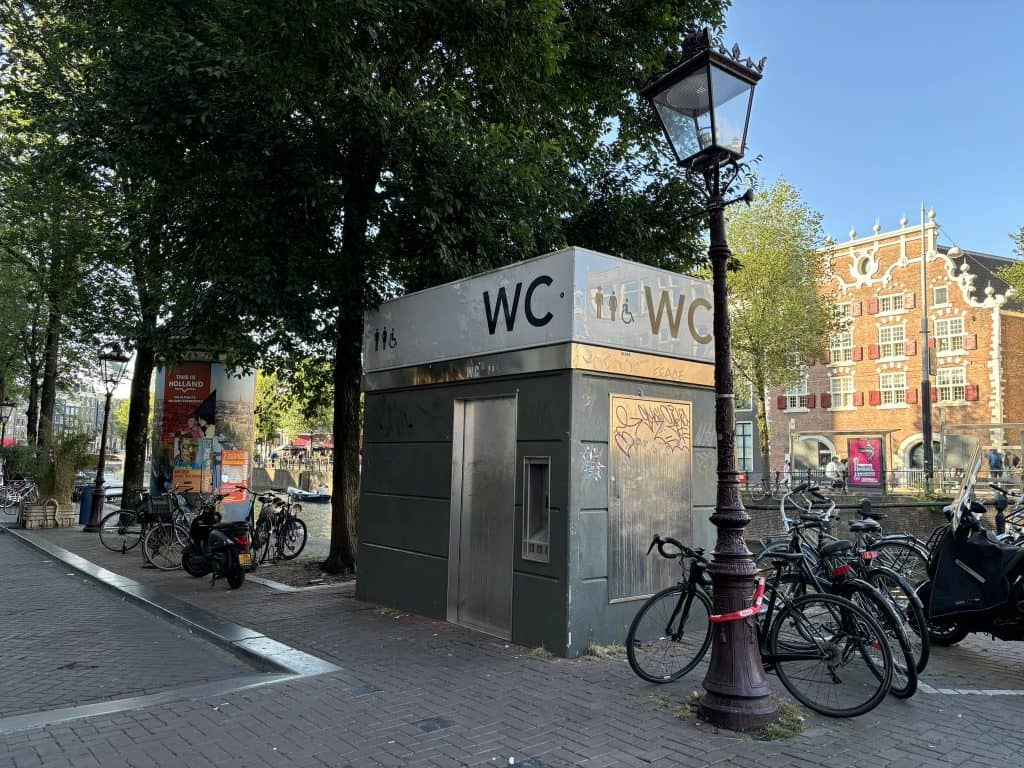
All gender, wheelchair accessible public toilet in Amsterdam – for a small fee and out of service.
The public toilets of Amsterdam have a range of qualities to them. Most notably, the pee curls provide places for men to pee in a relatively safe and controlled space, yet the smell and lack of an appropriate fixture for women remain issues. The pop-up toilets with an enclosed stall and separate urinals have a number of design advantages including the privacy, durability, and hygienic programming. For example, the urinals are flushed six times per hour, helping keep it clean and reduce odor. They also address the demands of night life activity. Unfortunately, the pop up toilets are not open on a regular basis. During a recent trip to Amsterdam, over the course of a week I did not see any pop up toilets above ground and open for use, even in the night hours. People have also reported a lack of signaling when the toilet does rise, causing items or people on top of the structure to fall or get hurt when it is rising.
The enclosed, self cleaning restrooms provided throughout central Amsterdam provide a private room for all genders and are wheelchair accessible, yet were often found to be out of service, and require payment for use. Hopefully, with the increased funding for public restrooms, these can be serviced and reopened.
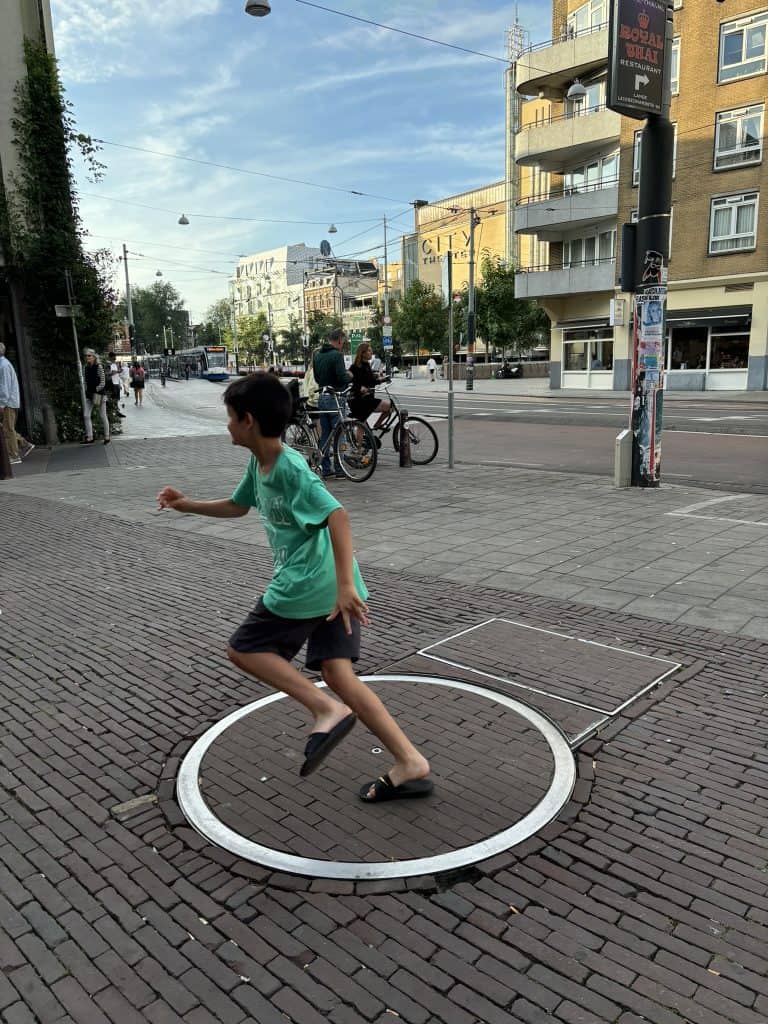
A child playing on top of a Pop-Up Urinal, or Urilift, currently underground and out of use.
Conclusion
While Amsterdam has a long history of addressing public urination, they are behind compared to other cities in addressing equity in restroom access. The traction over this issue has caused women’s groups and some government officials to tackle this potty parity issue. For example, the Lapee and Peequal were both designed to become women’s urinals, comparable to the pee curl. Hopefully, with the added momentum and planned funding, the current infrastructure is maintained and more public toilets, for all users, are installed to improve the public life experience.
If any readers have further insight on Amsterdam’s public toilets today or are interested in continuing the conversation, feel free to reach out to Margot Kleinman at mkleinma@pratt.edu. Continue following along to see the biweekly posts of research to learn more about public toilets design! All work included belongs to Pratt Institute.

